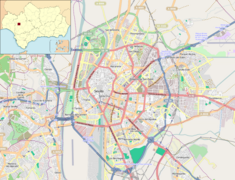General Archive of the Indies
| General Archive of the Indies | |
|---|---|
|
Native name Spanish: Archivo General de Indias |
|

The Archivo de Indias, Seville
|
|
| Location | Seville, Andalusia, Spain |
| Coordinates | 37°23′02″N 5°59′31″W / 37.384°N 5.992°WCoordinates: 37°23′02″N 5°59′31″W / 37.384°N 5.992°W |
| Built | 16th century |
| Architect |
Juan de Herrera Juan de Mijares |
| Architectural style(s) | Renaissance |
| Official name: Cathedral, Alcázar and Archivo de Indias in Seville | |
| Type | Cultural |
| Criteria | i, ii, iii, vi |
| Designated | 1987 (118th session) |
| Reference no. | 383 |
| Region | Europe |
The Archivo General de Indias (Spanish pronunciation: [aɾˈtʃiβo xeneˈɾal de ˈindjas], "General Archive of the Indies"), housed in the ancient merchants' exchange of Seville, Spain, the Casa Lonja de Mercaderes, is the repository of extremely valuable archival documents illustrating the history of the Spanish Empire in the Americas and the Philippines. The building itself, an unusually serene and Italianate example of Spanish Renaissance architecture, was designed by Juan de Herrera. This structure and its contents were registered in 1987 by UNESCO as a World Heritage Site.
The origin of the structure dates to 1572 when Philip II commissioned the building from Juan de Herrera, the architect of the Escorial to house the Consulado de mercaderes of Seville. Until then, the merchants of Seville had been in the habit of retreating to the cool recesses of the cathedral to transact business.
The building encloses a large central patio with ranges of two storeys, the windows set in slightly sunken panels between flat pilasters. Plain square tablets float in the space above each window. The building is surmounted by a balustrade, with rusticated obelisks standing at the corners. There is no sculptural decoration, only the discreetly contrasting tonalities of stone and stucco, and the light shadows cast by the slight relief of the pilasters against their piers, by the cornices, and by the cornice strips that cap each window.
The building was begun in 1584 by Juan de Mijares, using Herrera's plans, and was ready for occupation in 1598, according to an inscription on the north façade. Work on completing the structure proceeded through the 17th century, directed until 1629 by the archbishop Juan de Zumárraga and finished by Pedro Sanchez Falconete.
...
Wikipedia

